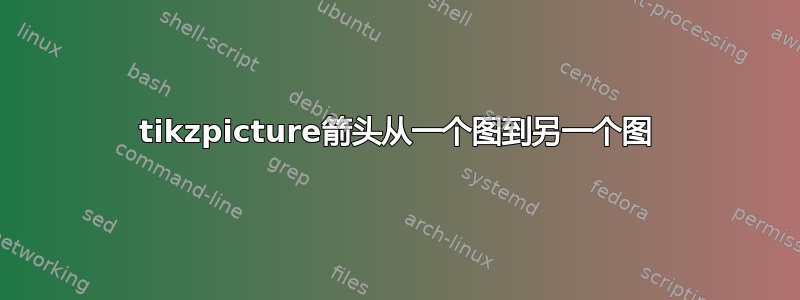
我是 tikz 的新手,我想做一些类似下图的事情:
[![多条曲线绘制至矩阵[1]](https://i.stack.imgur.com/0COKo.jpg)
我尝试做一些事情,但我不知道如何将矩阵放在图的左侧并在它们之间画一个箭头?
\begin{tikzpicture}[cell/.style={rectangle,draw=black},
space/.style={minimum height=1.5em,matrix of nodes,row sep=-
\pgflinewidth,column sep=-\pgflinewidth,column 1/.style=
{font=\ttfamily}},text depth=0.5ex,text height=2ex,nodes in empty cells]
\matrix (matrice) [
space,
column 2/.style={minimum width=5em,nodes={cell,minimum width=3.5em}},
column 3/.style={nodes={cell,minimum width=4em}},
column 4/.style={nodes={cell,minimum width=4em}}]
{
$t_1$ &6 & 6 & 7 \\
$t_2$ &3 & 3.5 & 8 \\
$t_3$ &4 & 9 & 9 \\
$t_4$ &7 & 9 & 0 \\ };
\begin{axis}[left= of matrice,
xlabel=time,
ylabel=$f(\textrm{temps})$,
xtick distance=1,
legend pos=north west
,grid=major]
\addplot [color=green] table {
Date GDP
1 6
2 3
3 4
4 7
};
\addplot [color=blue] table {
Date X
1 5
2 4
3 5
4 4
};
\addplot [color=red]table {
Date X
1 5.2
2 4.2
3 5.1
4 4.05
};
\addplot [color=purple]table {
Date X
1 3.2
2 4.2
3 5.19
4 4.05
};
\legend{$sensor 1$, $sensor 2$, $sensor2$}
\end{axis}
\end{tikzpicture}
回复@Zarko,你的回复对我有帮助,但我仍然对(时间和价值)轴有问题,如下图所示(为什么数字在水平线上方?!):
新的代码是(事实上我不能使用独立类,因为我使用了书籍类):
\begin{tikzpicture}
\begin{axis}[name=p, legend pos=north west, grid =major, symbolic x coords={$t_1$,$t_2$,$t_3$,$t_4$,$t_5$,$t_6$,$t_7$,$t_8$,$t_n$}]
\addplot+[smooth] coordinates {
($t_1$,42)
($t_2$,50)
($t_3$,80)
($t_4$,60)
($t_5$,62)
($t_n$,90)};
\addplot+[smooth,color=red] coordinates {
($t_1$,45)
($t_2$,30)
($t_3$,70)
($t_4$,90)
($t_5$,32)
($t_n$,50)};
\addplot+[smooth,color=green] coordinates {
($t_1$,35)
($t_2$,20)
($t_3$,80)
($t_4$,60)
($t_5$,22)
($t_n$,40)};
\legend{\emph{capteur} 1, \emph{capteur} 2,\emph{capteur} 3}
\end{axis}
\matrix (matrice) [matrix of math nodes,
nodes={draw, font=\ttfamily,
minimum width=4em, text depth=0.5ex, text height=2ex},
column sep=-\pgflinewidth, row sep=-\pgflinewidth,
right=of p] {
& {\color{red}$c_1$} & {\color{blue}$c_2$} &{\color{green}$c_3$} \\
$t_1$& 6 & 6 & 7 \\
$t_2$ & 3 & 3 & 8 \\
$t_3$ & 4 & 9 & 9 \\
$t_4$ & 7 & 9 & 0 \\
$t_5$ & . & . & . \\
$.$ & . & . & . \\
$.$ & . & . & . \\
$.$ & . & . & . \\
$t_n$ & 7 & 9 & 0 \\
};
\draw[ultra thick,-Straight Barb, shorten <=1mm, shorten >=1mm,color=black]
(p) -- (matrice);
\end{tikzpicture}
序言部分
` \documentclass[a4paper,11pt]{book}%,12pt draft twoside
\def\version{0.5}
% \def\padding{\input{padding.txt}}
\def\x{\ensuremath{\times}}
\def\bul{\ensuremath{\bullet}}
\def\cir{\ensuremath{\circ}}
%\def\release{v.\version, r.\svnrev}
\usepackage[frenchb]{babel}
\usepackage[latin1]{inputenc}
\usepackage[T1]{fontenc}
\usepackage{aeguill}%défaut [lm]
\usepackage{palatino}
\usepackage{mathpazo}
\linespread{1.02}
\newcommand{\mc}[3]{\multicolumn{#1}{#2}{#3}}
\newcommand{\mr}[3]{\multirow{#1}{#2}{#3}}
\newcommand{\note}[1] {\marginpar[\raggedleft\footnotesize\itshape#1\par{\raggedright\footnotesiz\itshape#1\par}}
\newcommand{\removenotes}{\renewcommand{\note}[1]{}}
\newcommand{\vertc}[1]{\rotatebox{90}{\textbf{#1}}}
\newcommand{\vertcr}[1]{\rotatebox{-90}{\textbf{#1}}}
\newcommand{\vertcn}[1]{\rotatebox{90}{#1}}
\usepackage{url}
\usepackage{xspace}
\usepackage[active]{srcltx}
\usepackage{moreverb}
%\usepackage{svn-multi}
% \svnid{$Id: MainThese.tex 401 2008-05-15 16:59:00Z rthion $}
\usepackage{datetime}
\usepackage{amsmath}
\usepackage{amsthm}
\usepackage{amssymb}
\DeclareMathOperator{\precprec}{ \prec\!\prec}
\DeclareMathOperator{\succsucc}{ \succ\!\succ}
\theoremstyle{plain}
\newtheorem{thm}{Théorème}%[thm]
\newtheorem{prop}{Proposition}%[thm]
\newtheorem{defni}{Définition}
\newtheorem{lemma}{Lemme}
\usepackage[french,vlined,linesnumbered,algoruled,lined,boxed]{algorithm2e}
\overfullrule=5pt
\usepackage[a4paper, hmarginratio=1:1]{geometry}
\geometry{marginparwidth=3cm}
\addtolength{\headheight}{2.3pt}
\parskip=5pt
\usepackage{graphicx}
\usepackage{epsfig}
\usepackage{subfigure}
\usepackage{wrapfig}
\usepackage{tabularx,lscape,longtable,booktabs}
\usepackage{slashbox}
\usepackage{multirow}
\renewcommand{\multirowsetup}{\centering}
\usepackage{rotating}
\tolerance = 400
\hyphenpenalty=50
\hbadness = 1500
\hfuzz 0pt
\emergencystretch 1em %\emergencystretch 1.5em
\clubpenalty=9999
\widowpenalty=9999
% \widowpenalty=10000
\vfuzz \hfuzz
\raggedbottom
\usepackage{lettrine}
\usepackage[usenames]{color}
\usepackage[table]{xcolor}
\definecolor{gris10}{rgb}{0.75,0.75,0.75}
\definecolor{gris60}{rgb}{0.60,0.60,0.60}
\definecolor{gris80}{rgb}{0.40,0.40,0.40}
\usepackage[usenames,dvipsnames]{pstricks}
\usepackage{pst-grad} % For gradients
\usepackage{pst-plot} % For axes
%\usepackage{algorithm}
\usepackage{algorithmic}
\usepackage[helvetica]{quotchap}
\makeatletter\def\@seccntformat#1{\protect\makebox[0pt][r]{\csname the#1\endcsname\hspace{12pt}}}\makeatother
\usepackage{titlesec}
\titleformat{\paragraph}[hang]
{\normalfont\normalsize\bfseries}{\theparagraph}{1em}{}
\titlespacing*{\paragraph} {0pt}{1ex plus 1ex minus .2ex}{0pt}
\usepackage{fancyhdr}
\pagestyle{fancyplain}
\renewcommand{\chaptermark}[1]{\markboth{Chapitre \thechapter.\ #1}{}}
\renewcommand{\sectionmark}[1]{\markright{Section \thesection.\ #1}}
\lhead[\fancyplain{}{\bfseries\thepage}] {\fancyplain{} {\bfseries\rightmark}}
\rhead[\fancyplain{}{\bfseries\leftmark}] {\fancyplain{}{\bfseries\thepage}}
\cfoot{}
\let\origdoublepage\cleardoublepage
\newcommand{\clearemptydoublepage}{%
\clearpage
{\pagestyle{empty}\origdoublepage}%
}
\let\cleardoublepage\clearemptydoublepage
%\usepackage[a4paper,ps2pdf,linktocpage,bookmarksnumbered,pagebackref]{hyperref}
\usepackage[linktocpage,bookmarksnumbered,pagebackref]{hyperref}
\usepackage[subfigure]{tocloft}
\usepackage[section,notlof,notlot,notbib]{tocbibind}
\setcounter{secnumdepth}{3}
\setcounter{tocdepth}{2}
\usepackage{float}
\floatstyle{ruled}
\newfloat{floexample}{thpb}{loe}[chapter]
\floatname{floexample}{Exemple}
%\newcommand{\listdefinitionsname}{Liste des définitions}
%\renewcommand{\listtablename}{Liste des tables}
\newlistof[chapter]{definitions}{def}{\listdefinitionsname}
\setlength{\cftchapnumwidth}{2em}
\setlength{\cftbeforechapskip}{2ex} %réduit l'espacement
\setlength{\cftbeforesecskip}{0.5ex} %réduit l'espacement
\setlength{\cftdefinitionsindent}{1.5em}
\setlength{\cftdefinitionsnumwidth}{2.3em}
\usepackage[french,nohints]{minitoc}%
\mtcsettitle{minitoc}{Plan du chapitre}
\mtcsetfeature{minitoc}{after}{\clearpage}
\mtcsetdepth{minitoc}{2}
\newenvironment{defn}[1]
%encapsulation de l'env théorème defni
{
\begin{defni}[#1]
{
\refstepcounter{definitions}
}
{
\addcontentsline{def}{definitions} {\protect\numberline{\thedefinitions}{#1}}
}
}
{
\end{defni}
}
\newenvironment{exemple}[1]
%def de l'environnement "exemple" qui encadre la description d'un exemple et numérote par chapitre
{ \begin{floexample}
\begin{center}
\begin{minipage}{.9\textwidth}
\caption{\sffamily #1} \sffamily \small \medskip
}%à l'ouverture \begin
{ \end{minipage}
\end{center}
\end{floexample}
}%à la fermeture \end
\newenvironment{myQuote}
{ \begin{quote} % \hspace{-5pt}
\itshape
}%à l'ouverture \begin
{
\end{quote}%\par
}%à la fermeture \end
\newenvironment{resume}
{ %\textsc{Résumé}
% \itshape \small
\vfill \itshape \small %\sffamily
$\vartriangleright$}
{ $\vartriangleleft$ \par \vfill
\clearpage
\minitoc}
%------------------------------------------------------------------------------------
% Infos spécifiques aux pdfs
%---------------------------------------------------------------------- --------------
\hypersetup{
pdfauthor = {},%
pdftitle = {},%
pdfsubject = {},%
pdfkeywords = {},%
}
\usepackage{pgfplots}
\pgfplotsset{compat=1.15}
\usepackage{tikz}
\usetikzlibrary{arrows.meta}
\usetikzlibrary{matrix,shapes,arrows,fit}
\usetikzlibrary{shapes.geometric}
\usetikzlibrary{shapes.misc}
\usetikzlibrary{matrix,shapes,arrows,fit,tikzmark}
\usepackage{verbatim}
\usetikzlibrary{graphs,graphs.standard}
\usepackage{tabularx}
\newcolumntype{L}{>{\raggedright\arraybackslash}X}
% définition des styles
\tikzstyle{lien}=[->,>=stealth]
\tikzset{individu/.style={#1!100},individu/.default={black}}
\tikzset{
every picture/.style={remember picture,baseline},
every node/.style={anchor=base,align=center,outer sep=1.5pt},
every path/.style={thick},
}
\newcommand\marktopleft[1]{%
\tikz[overlay,remember picture]
\node (marker-#1-a) at (.1em,.3em) {};%
}
\newcommand\markbottomright[1]{%
\tikz[overlay,remember picture]
\node (marker-#1-b) at (.1em,.3em) {};%
\tikz[overlay,remember picture,inner sep=5pt]
\node[draw=red,rounded corners,fit=(marker-#1-a) (marker-#1-b)] {};%
}
\usetikzlibrary{positioning}
\tikzset{main node/.style={circle,fill=blue!20,draw,minimum size=1cm,inner sep=0pt},
}
\let\clipbox\relax
\usepackage{adjustbox}
\usepackage{rotating}
\DeclareMathOperator{\e}{e}
\DeclareMathOperator*{\argminA}{arg\,min}
\DeclareMathOperator*{\argminB}{argmin}
\DeclareMathOperator{\E}{\mathbb{E}}
%\usepackage{algpseudocode}
\newtheorem{theorem}{Theorem}
\newcommand{\listtheoremname}{Liste des Théorèmes}
\newcommand\numberthis{\addtocounter{equation} {1}\tag{\theequation}}
\usepackage{pifont}
\newcommand{\cmark}{\ding{51}}%
\newcommand{\xmark}{\ding{55}}%
%\newtheorem{lemma}{lemme}
%\usepackage{ams}
\def\T{\rm T}
\def\M{\rm M}
\def\R{\rm R}
\def\RR{\mathbb R}
\def\D{\rm D}
\def\L{\rm L}
\def\I{\rm I}
\def\W{\rm W}
\usepackage{bm}
\usepackage{bibentry}
\usepackage{epstopdf}
\usepackage{pdfpages}
\providecommand{\keys}[1]{\textbf{\textit{Keywords---}} #1}
\usepackage{pgfplots,pgfplotstable}
\usepgfplotslibrary{dateplot}
\usepackage{pgfplots}
\pgfplotsset{compat=1.15}
\pgfplotsset{xticklabel={\tick},scaled x ticks=false}
\pgfplotsset{plot coordinates/math parser=false}
\usetikzlibrary{arrows.meta, matrix, positioning}
`
答案1
编辑(1):
同时我发现我们可以给图表命名并将所有图像绘制为一幅图:
编辑(2):
- 被视为表格,如您编辑的答案中所示
- 请使用中的代码,
pgfplots就像matrix我的答案中一样。你的修改会引入错误
就这三幅图而言:
\documentclass[margin=3mm]{standalone}
\usepackage{pgfplots}
\pgfplotsset{compat=1.15}
\usetikzlibrary{arrows.meta, matrix, positioning}
\begin{document}
\begin{tikzpicture}[node distance=22mm]
\begin{axis}[
name=p,
xlabel = time,
ylabel =$ f(\textrm{temps})$,
xtick distance=1,
grid=major]
\addplot table {Date GDP
1 6
2 3
3 4
4 7
};
\addplot table {Date X
1 5
2 4
3 5
4 4
};
\addplot table {Date X
1 5.2
2 4.2
3 5.1
4 4.05
};
\addplot table {Date X
1 3.2
2 4.2
3 5.19
4 4.05
};
\legend{\emph{sensor} 1, \emph{sensor} 2, \emph{sensor} 3,\emph{sensor} 4}
\end{axis}
\matrix (matrice) [matrix of math nodes,
nodes={draw, font=\ttfamily,
minimum width=3em, text depth=0.4ex, text height=1.75ex},
column sep=-\pgflinewidth, row sep=-\pgflinewidth,
right=of p] {
t_1 & 6 & 6 & 7 \\
t_2 & 3 & 3.5 & 8 \\
t_3 & 4 & 9 & 9 \\
t_4 & 7 & 9 & 0 \\
};
\draw[ultra thick,-Straight Barb, shorten <=2mm, shorten >=2mm]
(p) -- (matrice);
\end{tikzpicture}
\end{document}





